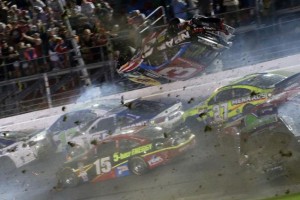
When the dust settled on what was the ultra-violent and visually horrific completion of the NASCAR Sprint Cup Series Coke Zero 400 very early Monday morning at Daytona International Speedway, six-time series champion Jimmie Johnson expressed sincere disbelief that driver Austin Dillon was still alive.
Absorb that for a minute.
As Dale Earnhardt Jr. came to the checkered flag for the Coke Zero 400 a chain reaction wreck set off behind him sending Dillon’s car in flight and into the catch fence.
And like what has been seen so many other times recently when cars have so regularly gotten airborne during NASCAR restrictor plate events and flown into the fences, Dillon’s car was chopped up like cheese to a grater and spit back out onto the track, with pieces of debris sent flying toward fans.
A gaping hole was left in the fence. What little was left of the core of Dillon’s car was left smoking and upside down on the track. Dillon walked away.
And Jimmie Johnson said he was shocked that Dillon was alive. Not shocked that he was uninjured. Shocked that he was not dead.
Need any further proof that the drivers are the Christians and restrictor plate facilities of NASCAR are the lions ready to fight them to the death like it’s a Roman Coliseum? There you go. Jimmie Johnson said he was shocked that Austin Dillon lived through that gruesome final lap crash at Daytona.
The first question asked by so many who can understandably absorb that something is very wrong with the death-wish type racing that has become events at the 2.5-mile Daytona International Speedway and the 2.66-mile Talladega Superspeedway, is typically, how do you fix it?
To many, the thought of making major changes to the layouts at Daytona and Talladega seems on the surface outlandish. Both are classic venues of the sport’s history. They are the greatest coliseums that NASCAR plays and such a part of the very fabric that is the legacy of stock car racing.
The fact is, if you can’t keep the cars from flying then maybe the time has come to stop racing on a track where it happens with all too much regularity of late.
You can’t keep hurtling 3,000 pound plus racecars into fences over and over without tragedy eventually taking place. When it becomes no longer shocking, but rather fairly expected, something needs to change drastically.
Across the spectrum of competition, evolution changes sports in plenty of different ways. And it’s been seen plenty in NASCAR too, from the organizational structure of teams at the sport’s highest level to the changes in point systems to continued improvements in the safety of racing facilities and vehicles. Change born of growth and evolution is only natural.
In the realm of NASCAR in 2015 competition at Daytona and Talladega is essentially akin to old-style leather helmets being worn for an NFL game.
They don’t work.
You can play with the variables all you want to try to find a happy medium so it feels safe, but eventually you have to address the core of the problem, that you’re playing with the technology of 2015 on a playing field that was built to hold up to the standards and technology of 1960’s racecars.
The sport, the cars, the technology of the game, it has left these tracks behind. Though, NASCAR desperately clings to these antiquated behemoths. Nobody wants to close the Roman Coliseum, for where shall we see the Christians slaughtered by the lions?
Yes, motorsports are inherently dangerous. Yes, we’ve heard that used as a sooth the pain mantra for tragedy in racing for years. But there’s inherently dangerous and then there’s purposely dancing on the edge of disaster lap after lap after lap and calling that competition.
In February 2013 at Daytona it was Kyle Larson’s car during an XFINITY Series event ending up launched and thrown into the fence.
When the dust settled on that tornado of a wreck, the front end of Larson’s car was shredded. A tire assembly ended up high in the grandstand. The burning motor from Larson’s car ended up just feet from the grandstands. Fourteen fans were injured that day by flying debris.
A gaping hole was left in the fence where Larson’s car hit it. A very similar massive hole was left by Dillon’s car Monday morning.
The quick reaction of many in the sport was the same for both incidents, which is the now cliché term in NASCAR that: “The fence did its job.”
The reality is, NASCAR is playing an appalling lottery with the fence “doing its job”. The dirty little secret nobody wants to talk about is that the fence does do its job for one car.
But here’s the all too probable “What if?” when you start sending cars in the air with the regularity of airliners taking off at LaGuardia Airport, like has been happening in recent years at restrictor plate events.
One of these times, after one car leaves that gaping hole in the fence, another flying car behind it is going to find that hole and take an unfettered flight into the grandstands.
You think the Confederate Flag issue is causing NASCAR headaches now? Send a full racecar into the grandstands at Daytona and see what controversy is really about.
No fan should have to go to a racetrack worried about being killed, but yet NASCAR has allowed that to become an all too familiar fear at restrictor plate events.
This isn’t about improving the protection that stands between the competition and fans. It’s not about building a wall. This is about coming to grips with the fact that safely competing at these facilities is no longer feasible. This is about coming to the realization that to keep these facilities operating the tracks themselves have to be changed entirely.
There’s no longer shock seeing these flying car crashes taking places at these facilities, and that is a scary thing. It seems today it’s not a question of what might happen but rather when will the seemingly inevitable tragedy happen of either a driver being killed by one of these ghastly wrecks, or fans being killed.
And just sitting back and waiting for the when does it happen day to finally decide that change has long been needed should be unacceptable in the sport.



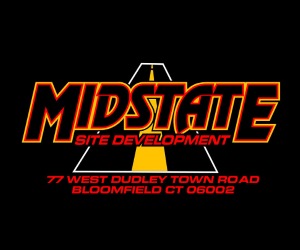











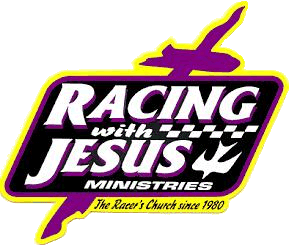

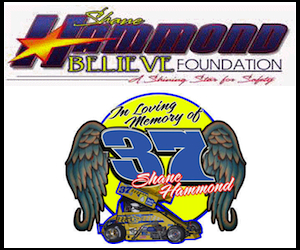
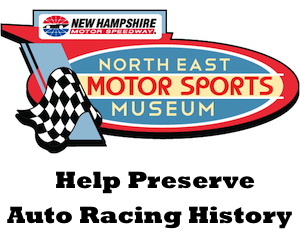
There’s no stoping it. It happened at lee a couple of weeks ago, it’s happened at stafford years back. It’s just part off the game that drivers and fans choose. You have know your surroundings and where you choose to sit. It can happen at any sporting event. You see kids with there parents at the bowl sitting in the first row playing and you think to yourself what if a car got into the fence there. That fence would not stop a car from going into the stands. Choose your seat wisely and pay attention . As for NASCAR the cars now are unbelievable. What these guys walk away from is scary and the fence did it job perfectly. You try to learn from it and make it better and move on.
Did it happen at Lee, too? I was there for the MRS race. Took me a couple hits to realize I was getting pelted by tire rubber… and I wasn’t sitting *that* close to the track.
I know a Super went into the frontstretch fence at Star a few weeks ago. I also remember Corky Cookman’s modified tragically going into the stands at Stafford.
As for the Cup series… The durability and protectiveness of the Cup cars is A-frickin-MAZING. But I hate plate racing with a passion. I think Daytona and Talladega are some of the absolute worst racing. I wouldn’t mind if the Cup series never went to a track bigger than Charlotte.
… “our saftey crews, bla bla bla…. the fence worked, bla bla bla (yea, today it did).. the way these cars are built today… the safer barier, the HANS device…” when will they look themselves in the mirror and address the real problem that is restrictor plate racing? Its all for TV ratings is the sad truth..
My personal opinion – I really don’t think we need racing in excess of 180mph – NASCAR, Indy car, F1.. the speeds just generate to much potential for disaster.
And at Stafford just a few weeks ago you had an sk light flipping through the air.
Maybe we need to step back and look at the “win at all cost” mentality of Nascar, and the “trying to win it on the first lap” of local drivers who aspire to be the next Joey Logano.
At what cost? And when will the cost be too great?
How many of us can raise our hands and say we were at a track when someone got killed?
And yet still we race.
RIP Tony Jankowiack
Mike86 it was star not lee. My fault.
Well, the drivers can stop making contact, stop trying to move cars out of the way, etc.
There’s too much contact between the cars.
Sharpie, you don’t get to dirt sprint cars shows too often do you. Cars flip all the time, many are into the fence. Most of the time nothing of consequence happens but sometimes it does. Racing is dangerous
(Wow that’s profound) as we all know and sometimes the fans are included. You go to a hockey game you might get hit with a puck or a stick fragment. You know the risks before you go…or at least you should.
NASCAR is continually improving it’s safety and I’m sure that will continue.
btw what does Tony Jankowiak”s crash in 1990 have to do with this?
“How many of us can raise our hands and say we were at a track when someone got killed?”
I saw a guy lose his life driving a 1934 MG in an SCCA Historic event, last fall at Lime Rock Park. RIP Lee Duran…
The vintage accident reminded me just how far safety technology has come protecting modern drivers, underscored again this morning at Daytona, but we’ve got to keep all of the parts and all of the fluids out of the stands, every single time.
AFAIK, there used to be seats much closer to the track where Dillon hit.
OK people, settle down. It was a green, white, checker finish at Daytona. The same thing can happen at slower speeds with no one giving an inch at the end of a race. Without the plates/restrictions( I know it is FI now). they would be in the 230+ range & you can really fly at those speeds.
If they changed the rules, & they could, it would be single file follow the leader parade & you would bitch that it is boring.
Enjoy what you have & appreciate that it is SAFER than ever.
I would like to see France and Helton put before a congressional comittee to answer questions publicly about fan safety. I want to see them squirm in their seats when they can’t come up with an answer for how they can protect fans from a flying race car. This will happen if a car lands on some fans causing multiple fatalities and the whole world sees it live on tv. It might take drivers and team owners to stand up to NASCAR about plate racing…they don’t seam willing to do that so I guess it doesn’t bother them too much. The only way to keep fans safe is to eliminate seating in the turns and tri-oval where cars actually race toward the stands. For example, Pocono only has seats on the main straightaway, no car ever flies into the fence on the straightaway. I know Pocono isn’t banked much and it’s not plate racing, but the general idea is the same. Didn’t NASCAR go to the restrictor plate when Bobby Allison tore down the fence at Talledega in the late 80’s? Great fix eh? I wish I had bought stock in the companies that make those plates!
I agree with everything in the article but the drivers dont give an inch. I heard Jimmie Johnson say yesterday before the race that Daytona is 90% looking at rearview mirror and 10% looking out the windshield. That’s not a good thing. They need to get away from this downforce era. Single file restarts could help on gwc finishes at Daytona and Talladega as well.
I agree with the concerns, however unless they a) get rid of the plate racing packs and b) move the seating audience back farther, you are going to continue to have what we have – including the “hold your breath” scenario around serious injuries.
I really think they need to get rid of the plates and go with an increased spoiler height, to start. Let’s at least test that combination out. Tire wear and handling should come back into play with an increase in rear downforce. The drivers have been screaming for years to put the driving more in their hands and get rid of the pack racing. i would think an aero and plate package change could do that. maybe they need to also mandate shocks, or even get ore drastic and narrow the tires for the current plat tracks.
Second, Denny Hamlin said it last night – move the fans back farther. Because it’s not going to be a case of IF a car gets through the fence and into the stands, it’s going to be WHEN and HOW FAR into the current seating area that car gets.
Now, are you going to be able to protect each and every fan from ever getting injured at a sporting event? No. NHL/MLB/PGA? Well, Pucks, broken bats and balls continue to fly into the crowds every o often. Always will. NBA? Well, no brawls have migrated into the stands lately…thank God.
So, the risk of freak injury to a fan will always be there. But since Daytona and Dega are NEVER going to come off the schedule, NASCAR needs to at least look at putting the fans at much less risk than they are at today.
As for the drivers? They accept the risk when they get in the car, have since they started racing. HOWEVER, each type of major racing has always had safety pioneers, and in the last 30 years there always seems to be a champion for safety emerging from the driver ranks. Back in the 70s it was Jackie Stewart in F1, Then Bill Simpson in the NHRA and branched out. Then Jeff Burton emerged as a big safety advocate for NASCAR – still is today – along with Ricky Craven and others, and John Force has become a leader in safety since Eric Medlen’s death. indyCar has had several drivers take on the leadership in safety as well.
So, safety has come a long way in all forms of racing for the drivers. With tremendous advances.
If Dillon had died in the accident,? It would have been tragic, but would not have been shocking…it might have even been “accepted”, for lack of a better word, as part of the risk in what they do when they get behind the wheel.
If fans were severely hurt or killed due to the 3 car’s accident? It would have been BEYOND tragic, and BEYOND acceptable.
Now, it might be time to look at the fans’ safety BEYOND what it is today…
SHAWN or whomever – if anyone hears how many Gs Dillon’s car encountered when it went from 180 mph to 0 in a matter of 25 feet, please post. How this one does not set a record, I do not know.
It’s part of the sport, get over it. Those bitching would also complain if a fan got hit with a golf ball. Bet not many remember when king petty barreled rolled 7 times taking down the fence then getting hit in the left front by Phil Barkdoll. The sport, like many others, is dangerous. No diffrent then baseballs going into the stands or pucks going over the glass. Get back in your bubble if you are afraid to participate in sports.
I can not see how moving the grandstand back farther is going to help also a single file restart on G W C is only going to be 2 and 3 wide racing by the time they get the white flag most of these problems are in the tri oval at Daytona and Talladega so why not put up a secondary fence behind the first one just in the tri oval areas? Shawn like you say a second car may find the whole from the first car a secondary fence may prevent that from happening.
There should be a net attached in a Bungee style to the end of the poles over hanging the track and secured to the wall at the base of the pole to begin absorbing some of the momentum. On the other hand it is just rich people sitting in the seats you used to have before the boom in the 90’s and Nascar began catering to people that weren’t coming back anyway and selling out what got them there in the first place.
Regarding the Gs…. the fence is very ‘soft’ and provided a ‘cushion’ of sorts.
Remember when Jimmie Johnson had a throttle stick and he went straight into a wall, but the wall had those blocks of cushions… it was scary to see but he climbed right out of the car with his arms in the air.
It doesn’t take too much to bring the peak Gs down. Dillon probably experienced higher Gs when the car landed on the track and was bouncing on the chassis.
Any time I go to a race I sit at the top. It doesn’t matter if it’s The Speedbowl or Daytona. It’s just a matter of time until a car or part of a car gets into the stands.
As most of you I have seen drivers killed at Stafford and Riverside park, accidents happen at all tracks but you can’t compare those tracks to Daytona. A car going 200 mph gets airborne can easily get thru the fence no matter how good its built and as the article says one of these times there might be a second car following it and nothing to stop it. You can’t protect the fans 100% of the time but we all know the risk we take we we go to the races. I was at Pocono back in the 70’s when they ran on the 2 1/2 mile track and we were sitting 3/4 of the way up the granstand on Saturday for qualifiying and a car blew it’s motor coming down the front stretch and a piece flew off the car and hit the empty seats a few rows in front of us so you can never be fully safe
The issue is debris getting into the stands. Look how the car broke apart and sent debris flying.
The big stuff won’t make it past the fencing, the little parts are another story.
That engine almost went in the stands. Bottom line is that NASCAR can’t continue to have fans getting hurt at it’s races. To suggest it’s just part of the game is foolish and I can assure you lawmakers won’t look at it that way and neither will the general public, most of whom haven’t been to a Cup race. If you think the fallout from the Confederate flag is big, that won’t be anything if a parent and some young kids get killed because part of a Cup car went in the stands.
NASCAR needs to keep the cars from flying in the air, and that likely means slowing them down a lot.
So what you’re saying Sect.D is it is okay if “rich people” are the one’s hurt or killed by a flying race car? The net idea sounds really brilliant by the way. Problem solved.
That’s what I said.
Chris, Just worry about that Teddy shirt you said you were going to bring me. It has been two weeks and you haven’t kept your word yet. XL please.
“The big stuff won’t make it past the fencing, the little parts are another story.”
Distance does lots to protect spectators from smaller parts and hot fluids. Not cheap to implement, but not requiring rocket-science engineering, either.
As part of the track’s remodeling project, they should have had a plan to make the stands similar to a place like Kentucky. The front row of the grandstands there seem at least halfway up the height of the fence if not more and there is no way for the fans to get down near the fence during the race. Stafford essentially has a short track version of that now.
Indianapolis Motor Speedway had to move spectator seating back in the late 70’s. I think all these Super Speedway’s should have done so long ago too. This past wreck could have easily turned into a Le-mans style catastrophe, changing the sport as we know it forever.
@Rapid Rick…
Exactly correct! I’ve had the pleasure of meeting John Fitch. His co-driver died in the infamous LeMans wreck, driving John to spend most of his life improving motorsports and highway safety.
Empty space solves lots of safety problems.
I was researching for my grandson, Corky Cookman’s great nephew. Yes, I am Corky’s sister.
I am commenting because Corky was killed in a track accident at Stafford in 1987 and earlier his car ended up in the stands when another driver caught his wheels coming around the third turn and sent Corky’s car airborne into the stands. Corky did 90% of the work on his cars himself. He had great respect for the car itself and the other drivers. Corky was called the “Gentleman Driver” because he wouldn’t hassle other drivers when they or he was having a bad night. He didn’t jockey just for the points. The reports on the most recent Daytona accident made it sound like one driver tried to push the other forward and ended up causing a terrible but thankfully not a fatal accident. To me, it sounds as if the drivers are no longer gentlemen and will do what ever it takes to hinder other drivers.